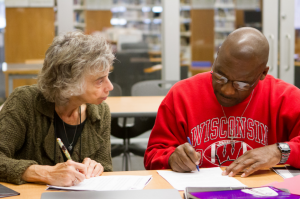Impacts of low literacy are far-reaching
by Lisa Speckhard
The amount of written information surrounding us is staggering: news, recipes, bus schedules, labels, signs, texts, emails and the omnipresent Google. The flow of information may be never-ending, but for many, this information is inaccessible.
It is estimated that one in seven adults in Dane County struggle with low literacy. This proportion comes with far-reaching implications. Viewed comprehensively, illiteracy is a debilitating disability that attacks self-worth, economic security and even health.
One in seven means that about 55,000 people in Dane County struggle with low literacy, based on the 2003 National Assessment of Adult Literacy. The Literacy Network, a local organization that provides classes and tutoring programs to improve reading, writing and speaking skills, breaks this number down into two categories: about two-thirds are English language learners, who primarily speak a different language, and the rest are adult basic education learners. The 2003 survey is the most recent data available, and the Literacy Network said there are indications that the numbers are now worse.
Low literacy, “roughly encompasses those who read at a sixth grade level or below,” said Jeff Burkhart, executive director of the Literacy Network. It can make basic tasks like filling out a job application or accurately reading a prescription label a struggle.
“Our education system has failed them,” Burkhart said. “I have met many people who grew up and went to school here who passed on, and who are reading at a second or third grade level. It’s tragic; it’s heartbreaking.”
Burkhart explained that students with undiagnosed learning disabilities are often the victims of this system. They may have been embarrassed because of their low reading skills, and then acted out as a defense mechanism, which led teachers to believe the student had a behavioral problem, rather than a learning problem.
In a literacy program evaluation report released in 2011, the Madison Metropolitan School District realized the problem of literacy gaps and vowed to focus on “ensuring our students are truly literate when they leave our classrooms and graduate from our schools.” Strategies included intensifying early reading instruction, rethinking professional development to prioritize literacy and providing more screening and instruction for those with potential reading problems.
But education is only part of the equation. Many adults who have low literacy today grew up in homes with parents of low literacy, creating a cycle that the Literacy Network wants to break.
Low literacy can be very damaging to self-confidence, especially for illiterate parents who cannot help their children with their schoolwork, which disrupts the traditional parent-child dynamic. When children realize their parent cannot help them, they may start to see their parent as inadequate.
“I think the parents are often feeling that their role as a parent is compromised,” Burkhart said.
Burkhart noted that this cycle disproportionately affects the African-American community in Dane County, and that illiteracy is a significant obstacle to employment and meaningful work. As the 2013 Race to Equity report pointed out, the unemployment rate for African-Americans in Dane County was at 25 percent, compared to just 5 percent for whites.
“Literacy is foundational to employees earning family-sustaining wages,” said Trena Anderson, a regional consultant for Wisconsin Literacy, a statewide coalition of over 70 literacy support organizations.
Literacy education can bring confidence and hope into an otherwise dark time, Burkhart said.
Burkhart told the story of a woman who, after the death of her alcoholic boyfriend, was devastated and struggling with suicidal thoughts.
A friend told her, “We’re going to find something that will help you find a reason to live and move forward in your life.”
The pair looked across the street from the woman’s house, and there was Literacy Network. She enrolled, and not only gained confidence, but also the first job she’d had in 20 years.
The friend who had encouraged her later told Burkhart, “I think, quite literally, the Literacy Network saved her life.”
While not everyone walking into a literacy program comes from such extreme circumstances, the Literacy Network often witnesses this transition from low self-worth to increased confidence and opportunities.
Literacy education can not only improve mental and emotional health, but may improve physical health as well.
Paul Smith, associate professor in the department of family medicine at UW-Madison, said research shows literacy is the “strongest predictor of health status.” One study showed that the “only other factor (other than literacy) that was stronger in terms of predicting mortality was people who were actively smoking.”
This does not mean that low literacy necessarily causes poor health, but rather that there is a strong association between the two factors. This is partially due to the fact that people with traditionally low literacy, such as men, low-income people and African-Americans typically have lower health levels.
But low literacy does affect health in direct ways. Those with low literacy can experience near-constant anxiety that they may be missing out on crucial information and are less likely to use preventive services.
“If you can’t read well, it’s really hard to function in our society, and that affects health,” Smith said.
Related Articles
Undocumented immigrants face ‘difficult choices’ regarding driving without a license – by Cara Lombardo
 The Arc: Visions of justice
The Arc: Visions of justice
